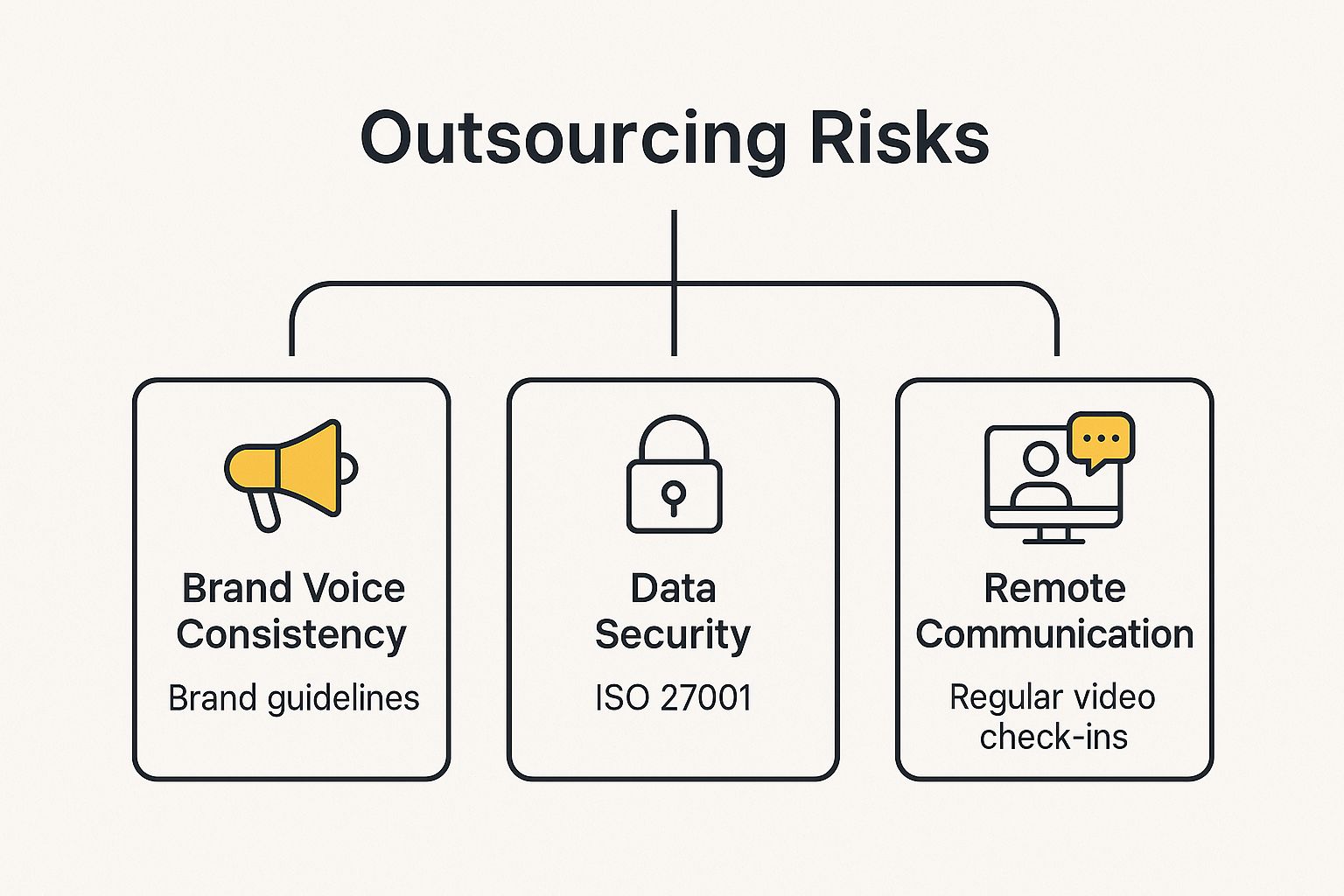When a business decides to outsource its customer service, it's making a strategic call to bring in an external company to manage all its customer interactions. This frees up the internal team to zero in on what they do best, leaving the support side of things to specialised experts. For a lot of Aussie businesses, this isn't just a passing trend; it's a fundamental part of their strategy for growth and efficiency.
Unpacking the Move to Outsource Customer Support

Think of it like a top-notch restaurant famous for its incredible main courses. Instead of trying to become master bakers overnight, the owners partner with a specialised local patisserie to supply world-class desserts. This lets the restaurant keep perfecting its core menu while still giving customers an amazing, complete dining experience. The outsourcing of customer service operates on the exact same principle—it's about smart partnerships, not just handing off tasks.
Australian businesses are leaning into this model not just to pinch pennies, but as a savvy response to today’s economic pressures and the ever-growing expectations of customers.
The Key Drivers Behind the Shift
So, what's pushing companies to look for outside help? A few big factors are at play, but the most significant is the relentless climb of operational costs. Running an in-house support team is about so much more than just salaries. You've got to factor in recruitment, proper training, software licenses, and the overheads for office space. For a growing business, these costs can spiral out of control pretty quickly.
Another massive driver is the modern customer's expectation of 24/7 availability. People want help instantly, whether it's 2 PM on a Tuesday or 2 AM on a Sunday. Building an internal team to cover every hour of the week is a huge logistical and financial headache. Outsourced providers, often spread across different time zones, can offer this round-the-clock coverage without a hitch.
It's estimated that 43% of companies now outsource at least some of their customer service operations. This clearly shows a major shift away from keeping everything in-house towards a more flexible, hybrid model for customer support.
Overcoming Scaling and Expertise Hurdles
Trying to scale an in-house team is another classic pain point. A sudden flood of customer enquiries—maybe from a new product launch or a seasonal rush—can completely swamp an internal team. You can't just hire and train new staff at the drop of a hat. Outsourcing gives you immediate access to a trained workforce, letting your business scale its support up or down as needed, without all the usual HR drama.
On top of that, outsourcing plugs you into specialised skills and technology that would be a massive challenge to build from scratch. Many providers offer support in multiple languages or have deep-seated experience in specific industries, which means a higher quality of service right from day one. Some businesses even look at different geographic options to find specific talent pools. For a great breakdown of this, check out this guide to nearshoring, including customer service.
Ultimately, it's about getting a competitive edge by tapping into external talent and infrastructure to deliver a customer experience that truly stands out.
The True ROI of Outsourced Customer Support

Sure, the immediate perks of outsourcing customer service are pretty obvious, but the real magic happens when you start calculating the return on investment (ROI). This isn't just about comparing hourly rates. The true financial punch comes from uncovering all the hidden expenses of running an in-house team and weighing them against the clean, predictable model of a professional partner.
Think of an in-house team’s cost like an iceberg. The salaries you pay are just the tip you can see. Lurking beneath the surface are a whole bunch of substantial, often-ignored expenses that can seriously bloat your budget.
Unpacking the Hidden Costs of In-House Support
When you build a team from scratch, you’re not just paying wages. You’re bankrolling an entire support ecosystem that adds up surprisingly fast. It’s in these indirect costs where the outsourcing of customer service often proves its worth.
Let's pull back the curtain on these expenses:
- Recruitment and Onboarding: Finding the right people is a mission in itself. There’s the cost of advertising roles, the time spent interviewing, and running background checks. Then, once you’ve hired them, they need thorough training, which usually means pulling your experienced staff away from their actual jobs.
- Technology and Infrastructure: Your team needs the right gear to get the job done. We're talking recurring costs for CRM software licences, phone systems, helpdesk platforms, and all the hardware needed to run everything smoothly.
- Office Overheads: Each new employee needs a desk and a chair, which means you’re on the hook for rent, utilities, and office supplies. These costs climb right alongside your team size, making it expensive to scale up.
- Employee Attrition: Let's be honest, customer service can be a revolving door. High staff turnover is common, and every time someone walks out, you're back to square one, kicking off that costly recruitment and training cycle all over again.
Outsourcing flips the script. It turns all those unpredictable, fluctuating expenses into a single, straightforward operational cost. This makes budgeting a breeze and frees up cash you can pump back into what really matters—like developing new products or ramping up your marketing.
The Value of Immediate Expertise and Scalability
When you partner with an outsourced provider, you get instant access to a team of pros who know their stuff. These agents are already trained in the best customer service practices and are up to speed with the latest support tech. Trying to build a team with that level of expertise from the ground up could take you years and a truckload of cash.
This immediate access to talent is a game-changer for staying nimble. A great real-world example is a case study on 50% cost savings in technical support pulled off by a consumer electronics brand.
And then there's the power to scale on demand. Imagine it's the holiday season and customer enquiries go through the roof. With an in-house team, you’d be scrambling to hire and train temporary staff—a messy and expensive process. An outsourced partner, on the other hand, can simply scale their team up to handle the rush and then scale back down when things quieten. You only ever pay for the support you actually need.
Outsourcing as a Strategic Financial Decision
The Business Process Outsourcing (BPO) scene in Australia is buzzing, with the number of businesses hitting 35,587. This growth isn't random; it's driven by smart companies looking to hand off key functions like customer service to get more efficient and boost their bottom line.
Making the call to outsource is a strategic financial move that has a direct impact on your profits. It’s not just about pinching pennies; it’s about transforming a hefty, fixed overhead into a flexible, variable expense that moves with your revenue. This gives you the agility to navigate market changes and jump on growth opportunities without the dead weight of a growing internal headcount. For businesses weighing up their options, getting a handle on the typical virtual receptionist cost can be a really useful starting point for comparison.
Navigating the Potential Risks of Outsourcing
While the benefits of outsourcing are compelling, any smart business owner knows you have to look at both sides of the coin. Handing over something as crucial as customer interaction isn't without its challenges, and these need to be managed proactively. It's when you ignore these risks that partnerships can falter. But if you tackle them head-on, potential drawbacks can become well-managed strengths.
The most common worries usually circle around keeping your brand's integrity, protecting sensitive data, and making sure communication is seamless with a team that isn't in the same building. The good news? Each of these hurdles has a clear, proven solution.
Maintaining Your Brand Voice and Identity
One of the biggest fears in the outsourcing of customer service is that an external team just won’t sound like your brand. Your brand’s voice is its personality—it’s what makes you recognisable and builds that all-important trust with your customers. Losing that consistency can weaken your identity and create a jarring experience for regulars.
To stop this from happening, you need to treat your outsourced team as a genuine extension of your own. This kicks off with creating a comprehensive brand bible or style guide. This document needs to be more than just logos and colours; it should detail your communication tone, specific phrases to use (and which ones to avoid), and your core company values.
From there, you can put some simple strategies in place:
- Joint Training Programs: Don’t just rely on the provider's standard training. Get your own team leaders involved in the onboarding process to instil your company culture and service standards right from day one.
- Clear Quality Assurance (QA) Frameworks: Set up specific metrics for success that align with your brand values, not just efficiency. Regularly review call transcripts and chat logs together with the provider to make sure the brand voice stays on point.
This infographic lays out the main risks and how to deal with them directly, giving you a clear framework to work from.

As you can see, every significant risk has a corresponding, actionable solution that turns a potential headache into a managed process.
Safeguarding Sensitive Customer Data
When you outsource customer service, you’re often sharing sensitive customer info—names, contact details, purchase histories. In the wrong hands, this data is a massive liability. A data breach can do irreparable damage to your reputation and land you in serious legal hot water. It's an absolute non-negotiable to make sure your partner takes security as seriously as you do.
The first step is doing your homework and vetting them properly. Don’t just take a provider’s word for it; ask for proof of their security measures.
A critical benchmark to look for is the ISO 27001 certification. This international standard confirms that the provider has a robust information security management system in place, covering everything from risk assessment to data encryption.
On top of that, your contract should include strict data protection clauses. These should clearly define who owns the data, how it can be used, and the exact steps to follow if a security incident ever happens. A partner who is transparent and proactive about their security is one you can trust.
Overcoming Communication Hurdles with Remote Teams
Working with a team in another city, or even another country, can naturally bring some communication challenges. Time zone differences, cultural nuances, and the simple lack of face-to-face interaction can lead to misunderstandings and a sense of disconnect between your core business and your support crew.
To bridge this gap, you need to set up a structured and consistent communication rhythm. Just relying on email is a recipe for delayed responses and mixed-up priorities. A multi-channel approach is far more effective.
Here’s what works well:
- Regular Video Check-ins: Schedule weekly or bi-weekly video calls with team leaders. Use this time to discuss performance, challenges, and any upcoming changes in the business.
- Shared Communication Channels: Use tools like Slack or Microsoft Teams to create a shared digital workspace. This is perfect for quick questions and real-time collaboration.
- Cultural Exchange: Make an effort to understand the cultural context of your outsourced team. This builds mutual respect and can seriously improve how well everyone works together.
By putting these clear, practical strategies into action, you can confidently manage the risks of outsourcing customer service. This way, you ensure the partnership is a powerful asset for your business, helping it grow.
How to Choose the Right Outsourcing Partner
Picking the right partner for your customer service outsourcing is a big deal. It’s less like hiring a temp and more like bringing on a business partner who will be the voice of your brand. This decision shapes how customers see you, so it needs more than a quick look at a price list.
Think of it like casting a lead actor for your company’s story. You wouldn't just grab the cheapest person off the street; you'd find someone who gets the role, fits the culture, and can deliver a performance that wows your audience. Your outsourcing partner deserves that same level of scrutiny.
Vetting Potential Partners for Technical and Cultural Fit
The real work starts when you dig into what a potential partner can actually do, not just what their sales pitch claims. A slick presentation is one thing, but you need to know if their operational setup and company culture will genuinely click with yours.
First up, their tech stack. In today's world, your customers expect to reach you on any channel without having to repeat themselves.
- Omnichannel Support: Can they handle phone, email, live chat, and social media as one seamless conversation? Nothing frustrates a customer more than a disjointed experience.
- CRM Integration: How easily can their systems plug into your existing CRM, like Salesforce or HubSpot? This isn't a nice-to-have; it's essential for keeping all your customer data in one place.
- Reporting and Analytics: What kind of numbers can they show you? You need a partner who is transparent with performance data so you can see what’s working and what’s not.
Just as crucial is the cultural fit. This team will be speaking to your customers every single day. If their values and communication style don't match yours, you’ll end up with a jarring experience that can push your customers away.
Critical Questions to Ask During Discovery Calls
Once you’ve narrowed down your list, the discovery call is where you get to pull back the curtain. Don't be shy—this is your chance to ask the tough questions that get past the marketing fluff.
Here are a few questions you should absolutely be asking:
- How do you train your agents on a new client's brand and products? If they give you a vague answer, that’s a red flag. You're looking for a clear, structured onboarding process.
- Can you walk me through your quality assurance process? Ask them how often they review calls and what specific metrics they track to measure performance.
- What’s your agent attrition rate, and what do you do to manage it? High turnover is a huge sign of trouble. It often means poor management, which will directly impact the quality of service your customers receive.
- How do you handle data security and comply with Australian privacy laws? They should be able to point to concrete certifications (like ISO 27001) and security protocols without hesitation.
Choosing a partner is a commitment. You’re handing them the keys to your most valuable asset—your customer relationships. The goal is to find a team that acts as a genuine extension of your own, one that’s just as invested in excellence as you are.
As you weigh up your options, it's also worth looking at the full spectrum of communication tools available, including a professional business answering service, to get a complete picture of what’s possible.
Comparing Customer Service Outsourcing Models
Before you sign on the dotted line, it’s important to understand that not all outsourcing is created equal. The right model for you will come down to your budget, your goals, and how much control you want to keep. Let's break down the main options.
Comparing Customer Service Outsourcing Models
This table helps businesses compare different outsourcing models to find the best fit for their needs, budget, and desired level of control.
| Model Type | Best For | Typical Cost Structure | Key Advantage | Main Consideration |
|---|---|---|---|---|
| Onshore | Businesses needing deep cultural alignment and serving a local market. | Per agent, per hour (highest cost). | Seamless brand voice and local knowledge. | Significantly higher operational expense. |
| Nearshore | Companies seeking a balance of cost savings and time zone alignment. | Per agent, per hour (moderate cost). | Reduced costs with minimal communication lag. | Potential for minor cultural nuances. |
| Offshore | Organisations focused on maximising cost efficiency and 24/7 coverage. | Per agent, per hour (lowest cost). | Substantial cost savings and global reach. | Requires robust management of cultural and language differences. |
| Hybrid Model | Businesses wanting to cover specific gaps like after-hours support. | Varies based on scope (e.g., fixed fee). | Fills internal gaps without full dependency. | Requires excellent coordination between teams. |
At the end of the day, the best partner is one who not only ticks all your technical and financial boxes but also genuinely cares about your success. Putting in the effort to properly vet them now will pay off massively in customer satisfaction and business growth down the track.
AI and the Future of Customer Interactions

While traditional outsourcing has been a go-to for Australian businesses for years, the ground is shifting beneath our feet. The conversation is no longer just about human teams in different locations; it’s now heavily focused on Artificial Intelligence (AI) as a powerful alternative.
Think of it like having an intelligent digital concierge for your business. This concierge is always on, can talk to thousands of customers at once, and never forgets a single detail. It directs simple queries, answers common questions in a flash, and makes sure every interaction is handled with perfect consistency. That's the new reality AI-driven call management systems are bringing to the table.
The Rise of the Digital Concierge
This isn't some far-off sci-fi concept; it's a practical step forward in the outsourcing of customer service. AI solutions are built to handle the high volume of routine calls that can easily bog down human agents. They shine at tasks that need speed, accuracy, and round-the-clock availability, completely changing how businesses can manage customer communications.
The advantages are pretty compelling:
- Elimination of Human Error: For repetitive jobs like booking appointments or answering FAQs, AI gets it right every single time, removing the risk of mistakes.
- Instantaneous Service: Customers hate waiting in queues. AI provides immediate responses, meeting the modern demand for instant support.
- 24/7 Unwavering Availability: AI doesn't need breaks, holidays, or sleep. It offers genuine round-the-clock service, ensuring no customer call ever goes unanswered, no matter the time.
AI platforms can analyse thousands of conversations to uncover trends, customer pain points, and product feedback—insights that would take a human team weeks to compile. This data becomes a goldmine for making smarter business decisions.
The Australian contact centre industry is getting on board with this tech, and fast. Driven by high staff turnover and the need for better efficiency, businesses are finding that AI adoption can achieve success rates of up to 64% in some outsourced contact centres. It’s a game-changer for improving both customer experience and day-to-day workflow.
A Strategic Partner, Not Just a Tool
It's crucial to see AI as more than just a cost-cutting gimmick. It's a strategic asset that lifts the entire customer service function. By automating all the predictable, simple tasks, AI frees up your human agents to focus on what they do best: handling complex, emotionally charged issues that require empathy, critical thinking, and a personal touch.
This creates a seriously powerful hybrid model. The AI acts as a hyper-efficient front line, filtering and resolving most of the interactions. This leaves your human team—whether they're in-house or outsourced—with more time and energy to deliver high-value, relationship-building support to the customers who really need it. In fact, over 70% of contact centres in Australia and New Zealand are now implementing generative AI, which shows a clear direction for the industry.
For many businesses, this approach offers the best of both worlds. You get the scale and efficiency of automation while keeping that invaluable human element for critical customer moments. Tools like an AI answering service are becoming a practical first step for businesses keen to explore this powerful synergy. This balanced strategy is quickly becoming the new benchmark for modern, effective customer service.
So, What’s the Right Call for Your Business?
Figuring out your customer support strategy is a massive decision. And let's be honest, it's not as simple as just choosing between keeping it in-house or shipping it out anymore. The path you take here will directly mould your customer relationships, how your business runs, and how fast you can grow. This is a big-picture call that needs to line up with where you are now and where you're heading.
We’ve basically walked through three main roads: building your own team, partnering up with a customer service outsourcer, or bringing in an AI-powered solution. Each has its own magic. An internal crew lives and breathes your brand like no one else can. A classic outsourcing partner gives you instant scale and expertise right off the bat. And AI? Well, that brings insane efficiency and round-the-clock service to the table.
Finding Your Perfect Fit
The best model for you is all about your unique situation. A startup with a super-technical product? You’d probably want a small, dedicated internal team who knows your product inside and out.
On the flip side, imagine a booming e-commerce store that gets slammed during the holidays. A flexible outsourcing partner would be a lifesaver, helping manage those crazy peaks without the cost of hiring permanent staff.
Then you’ve got the AI route. This is perfect for businesses drowning in the same old questions day in, day out. By letting AI handle the routine stuff, you free up your human team to focus on the tricky, high-value chats that actually build loyalty.
This isn't about finding one "best" answer for everyone. It's about crafting a customer service strategy that's as dynamic and ambitious as your business, setting a solid foundation for whatever comes next.
And don't just think of this as a way to cut costs; it's a direct investment in your brand's reputation. A massive 73% of consumers say customer service is a make-or-break factor in their buying decisions. That makes this one of the most critical operational choices you'll make.
Your Path Forward
So, what's the takeaway? It's simple: take a hard, honest look at your current customer service setup. Is it actually helping you grow, or is it holding you back? Use what we’ve talked about here to map out a plan that doesn't just keep customers happy but actually fuels your long-term success.
Whether you decide to sharpen up your in-house team, look into a strategic outsourcing partnership, or bring in smart automation, the end goal is always the same. Build a customer experience that’s quick, dependable, and ready to scale with you. Get this right, and you’ll turn your customer service from a cost centre into a powerful engine for growth.
Got Questions About Outsourcing Customer Service?
Thinking about outsourcing customer service? It’s a big move, and it’s smart to have questions. Getting clear on the common worries is the first step to figuring out if it’s the right play for your business.
Let's dive into the questions we hear most often from business owners.
How Much Does It Cost in Australia?
There's no single price tag here. The cost can swing pretty wildly depending on the type of service you need, how complex the work is, and where your team is located.
- Onshore (Aussie-based): This is your premium option. You get perfect cultural and language alignment, but it comes with the highest price.
- Offshore (e.g., Southeast Asia): This is where you'll find the biggest cost savings, often coming in at a fraction of the local price.
- Nearshore (e.g., Fiji): Think of this as the middle ground. It balances lower costs with better time zone alignment than many offshore locations.
Usually, you'll be priced per agent per hour, per ticket solved, or on a fixed monthly retainer. Make sure you get a detailed quote that breaks down exactly what you're paying for—from training and tech to reporting.
Will Outsourcing Tarnish My Brand?
That's a fair question, but here’s the thing: you're in the driver's seat. If you rush it or pick the wrong partner, sure, it can feel disconnected. But get it right, and a great outsourcing partner can actually boost your brand's reputation.
Think about it. They can deliver a more consistent, professional, and faster service than an in-house team that's already stretched thin.
The secret is finding a partner who genuinely gets your brand's values. Success hinges on a solid onboarding process, crystal-clear communication, and a tight quality control system to make sure your brand's voice always comes through loud and clear.
Can I Just Outsource a Part of My Customer Service?
You bet. In fact, a hybrid approach is one of the most popular and effective ways to go. Plenty of businesses choose to outsource specific roles to plug the gaps they have internally.
For instance, you could outsource:
- After-hours and weekend support to offer true 24/7 coverage.
- Tier 1 (the basic stuff), which frees up your in-house experts to tackle the really tricky issues.
- Just your phone calls, while your local team keeps handling emails and live chat.
This lets you tap into the flexibility and cost savings of outsourcing while keeping your hands on the most critical customer chats. It's a model that's catching on fast in Australia, where 69% of contact centre employees now work from home, often as part of these flexible, remote team setups. You can dig into the numbers in this in-depth analysis of Australian service industry trends.
Ready to stop missing calls and start growing your business? Let OnSilent handle your communications with an intelligent AI Call Assistant, giving you back hours every week. Discover how OnSilent can help you today.

